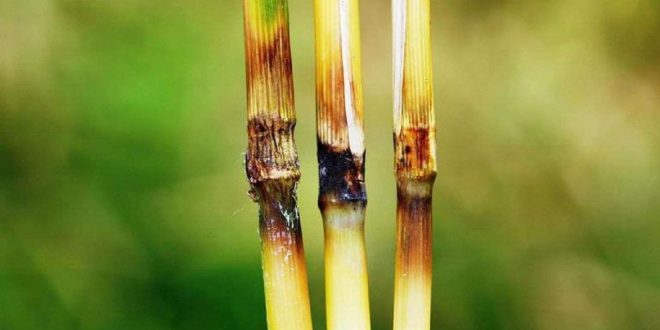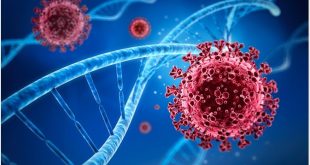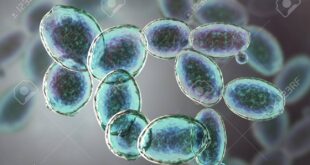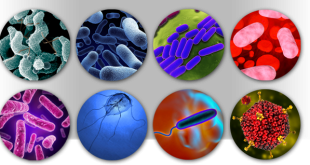According to Encyclopedia Britannica-
Plant disease is an impairment of the normal state of a plant that interrupts or modifies its vital functions.
The effects of a disease that can be observed are called the symptoms. A disease can be identified depending on the symptoms as different diseases show different symptoms.
Plant Disease Concepts
Ancient people considered plant disease as a punishment to people by GOD because of their sins. The Greek philosopher Theophrastus (300 B.C.) was the first to study plant disease. In his book “Enquiry Into Plants” he discussed plant disease. But he could not find out the actual reason behind plant disease. He considered it a curse.
After inventing the Compound Microscope scientists found out that many microorganisms are responsible for diseases in plants.
Based on the research on plant diseases, two basic concepts have been eventually developed. One is The Disease Triangle and another is The Disease Cycle.
Both of the concepts are described below briefly:
The Disease Triangle
Over the years, pathologists have come to learn that disease development in a plant population is determined primarily by the interactions among three major factors. These factors are:
- The Susceptible Host
- A Virulent Pathogen
- A Favourable Condition
The interactions among these three factors have been eventually conceptualized into the Disease Triangle.
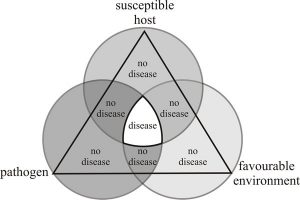
When these three components are present at the same time, the pathogen will be able to cause disease.
As shown in the above diagram, the pathogen will not be able to affect a plant under unfavorable conditions even if the host is susceptible. Likewise, a pathogen can not affect a plant under the favorable conditions if the host is not susceptible.
So conceptually, this triangle dictates that if either the host is less susceptible, the pathogen is less virulent or the environment is less favorable, the disease will either occur at a reduced level or it will not occur at all.
This should be kept in mind that there are numerous variables within each of the three factors which may affect the incident and severity of a disease. These variables include environmental conditions, genetic diversity, biology, and the life cycle of the host plant and pathogen, etc. These variables are described below in brief:
-
Environmental Condition
There are many variables in the environment that affect the incidence and severity of disease such as temperature, moisture, rainfall, sunlight, seasons, etc. Generally, a pathogen remains restricted in a certain area based on the micro-climate. The Micro-climate can be defined as “The prevailing climatic conditions in a certain geographical area”. Each geographical region can have several micro-climates depending on wind, amount of sunlight, moisture, etc.
-
Genetic Diversity
Genetic Diversity is defined as The number of different alleles and their frequency in a population.
Genetic diversity within host plants can greatly affect the susceptibility of hosts. If the host plant is genetically resistant to any particular disease, the pathogen will not be able to affect the plant body even under favorable conditions. The severity of the disease gets also influenced by genetic diversity.
-
Biology And Life Cycle Of The Host Plant & Pathogen
The life cycle of both pathogen and host can influence the occurrence of a disease. A pathogen may have to be in a critical stage of its life cycle to cause the disease. Likewise, a host may only be affected by a disease in a particular stage of the life cycle.
The Disease Cycle
Another important concept related to plant disease is Disease Cycle. A generalized figure of the disease cycle is given below:
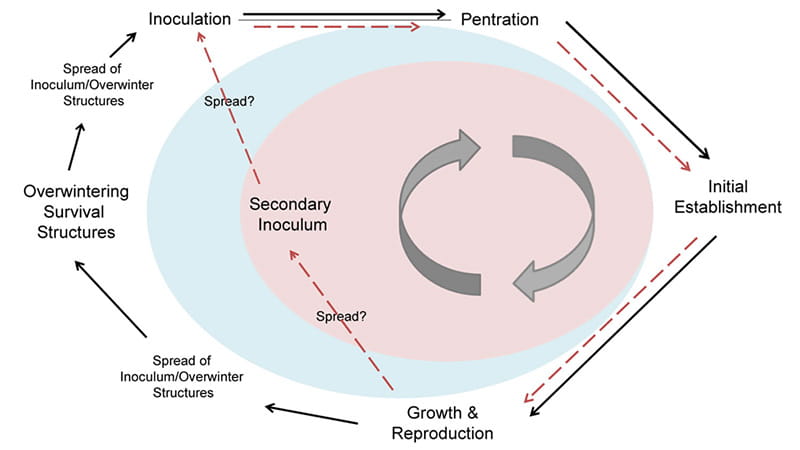
For a disease to be developed the pathogen has to go through a disease cycle to successfully invade the host plant. The Disease Cycle is the chain of events that occur during the development of a disease.
There are several stages of a disease cycle through which a disease eventually develops in the host plant. These stages are:
1. Inoculation
As shown in the figure above, the first stage of the disease cycle is inoculation when a pathogen is introduced to a susceptible host plant. Different pathogens employ different inoculation methods. Generally, pathogens are equipped with various mechanisms that help in inoculation. For example, some pathogens are spread by air currents while some other are spread by vectors (insects, birds, etc).
2. Penetration
After inoculation comes to the penetration stage where the pathogen enters the host tissue. Some pathogens enter through wounds, stomata, etc and some have special mechanisms that can directly penetrate the host tissue. Fungi and nematodes are able to actively penetrate the host tissue under favorable conditions.
3. Incubation
After invading the host plant a pathogen may undergo an incubation period. During incubation, the pathogen does not affect the host tissue and remains latent for a specific period of time.
4. Infection
After invading the host tissue the pathogens form parasitic relationships between the host plant and pathogen by absorbing nutrients from the host tissue and causing infection in the affected area of the plant body. This is the stage where the symptoms of a disease are visible. Depending on the pathogen the infections can be of various types based on which a disease can be identified
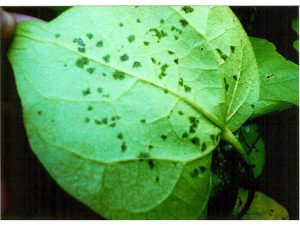
5. Reproduction
A pathogen can reproduce both sexually and asexually. Reproduction helps the pathogen to spread the disease to other susceptible hosts. For example, fungi produce spores through asexual reproduction and spread them through the air or water current which germinate on another susceptible host and invade it.
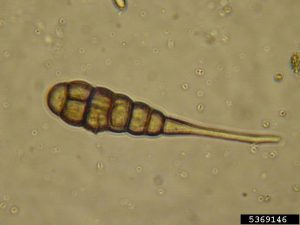
6. Survival
Pathogens have developed different mechanisms to survive in the host body under unfavorable conditions. These mechanisms help them to survive for a prolonged period of time. For example, soybean cyst nematodes lay their eggs within a cuticle casing. The casing is very hard which prevents other microbes and chemicals to penetrate and killing the eggs prior to hatching.
Any disturbance in any stage of the disease cycle influences the severity of the disease.
The knowledge of the ‘Basic Concepts Of Plant Disease’ is very important as it helps in disease management.
For more on the disease cycle, follow
- The Disease Cycle: An Introduction
- Inoculation and Penetration
- Infection and Dissemination
- Over-seasoning
Revised by
- Md. Siddiq Hasan on 01 October 2020
- Somudro Mahbub Nasir on 09 July 2021
 Plantlet The Blogging Platform of Department of Botany, University of Dhaka
Plantlet The Blogging Platform of Department of Botany, University of Dhaka
